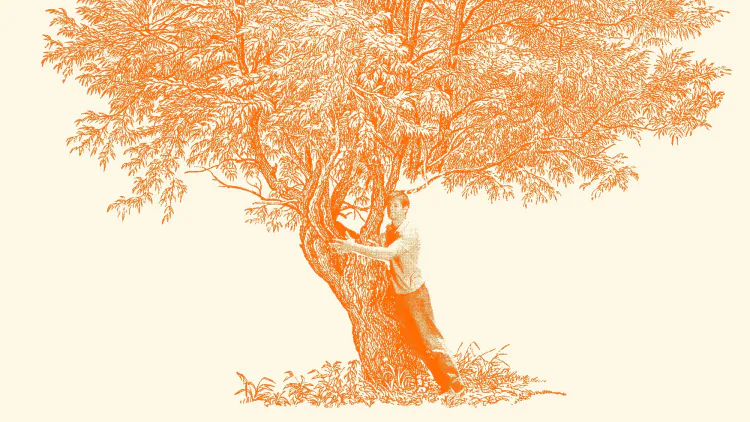The Art of Communing With Trees
What are we to make of a life that can age and grow young again at the turn of the seasons?

This is an edition of Time-Travel Thursdays, a journey through The Atlantic’s archives to contextualize the present and surface delightful treasures. Sign up here.
Trees can seem like timeless beings. Many a giant sequoia has racked up three millennia on this Earth. A pine in California’s White Mountains is estimated to be nearly 5,000 years old. A colony of aspens in Utah may well have originated during the Stone Age, and to this day, its leaves glitter gold in the autumn sun.
A tree’s life span, undisturbed by axe or fire, is utterly divorced from the scales on which human affairs operate. And yet, throughout history, people have seen themselves reflected in trees. One of those people was James Russell Lowell, a poet who served as The Atlantic’s first-ever editor. “I care not how men trace their ancestry / To ape or Adam; let them please their whim; / But I in June am midway to believe / A tree among my far progenitors,” Lowell wrote in The Atlantic’s June 1868 issue. He even suggests that “many a lifelong leafy friend” returns his affection: “Surely there are times / When they consent to own me of their kin.”
Lowell’s poem goes on to compare trees to ancient nymphs and to the very spirit of hospitality. But none of these images is as convincing as his vision of ancestor-trees, watching over children’s games and singing “faint lullabies of eldest time.” In June, how can one understand a tree as anything but eternal? It seems no more movable than the earth in which it is planted, incapable of anything but endless growth. Trees may be inscrutable—we can’t discern much about their inner lives—but when they are lush with leaves, they are undeniably certain.
Unlike Lowell, I feel most kinship with trees not when the first hot breaths of summer bathe the Northern Hemisphere, but at this time of year, when any given day might yield snow or blinding sun, or both. In spring, when the first hopeful blossoms and buds begin to pepper bare branches, a tree’s life suddenly moves as quickly as mine, if not quicker. The blooms’ frailty and evanescence seem transposed onto the entire organism, and suddenly, the tree is not an ancestor-deity, but mortal.
Even an ancient tree can seem childlike in March. In a story published in The Atlantic in 1877, a man walking through a grove remarks, “Trees, like children, reveal peculiarities of character more frankly in their budding-time than at maturer stages.” When trees fail to obscure their limbs, the narrator observes, ashes look especially feminine, and young oaks particularly athletic. Like children, they are vulnerable too: The man so fond of budding trees laments to an oak that men are “apt to fall treacherously upon you with the axe,” a tendency he deems a “special American barbarism.”
Ancestor-trees, child-trees: What are we to make of a life that can age and grow young again at the turn of the seasons, that equally distends and contracts our perception of time? Perhaps it is just this ambiguity that allows trees to be such a powerful avatar of humanity. Life, after all, is full of distended and contracted seasons.
In recent years, unpredictable weather has added new confusion to our already fluid sense of time’s passage. The country just experienced its warmest winter on record. In Maryland, where I live, half a foot of snow fell in mid-January; a week later, the weather was practically beachy. When I traveled to Vermont last month, the temperature rose 53 degrees in two days. The famous cherry blossoms in Washington, D.C., reached peak bloom last Sunday, earlier than almost any year on record.
I visited D.C’s Tidal Basin the day before peak bloom to commune with the child-trees, and found that the unnamed narrator in that 1877 story had a point: Each tree’s character was on full display. There were slender trees and muscular trees, trees that curved and trees whose limbs angled sharply, trees that reached high and trees whose lowest branches needed to be jumped over, trees that twisted and trees that stretched from the ground like telephone poles. The flowers were saturated pink and cottony white, scent-free and fragrant. Some trees were flush with blossoms, while others had only begun to bud.
Spectacular and ancient and delicate as the trees were, I didn’t immediately see them as ancestors or children or nymphs. Perhaps that shouldn’t have been a surprise. As the narrator said of his own dear trees, “All who knew the oaks seemed to have a conviction that they alone could understand them.” But as I shuffled along with the crush of people in the Tidal Basin, I found that the cherry blossoms had at least one ancestral effect: They had brought us all together to pay our respects to a shared inheritance.
What's Your Reaction?




















